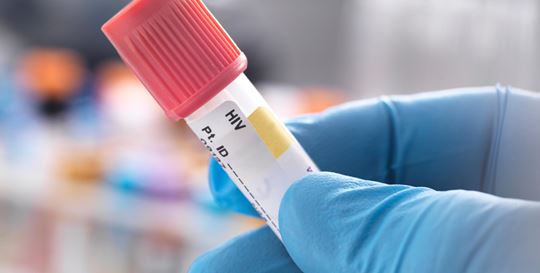It was 1981. Around the globe, music fans were recovering from John Lennon’s murder and focused on the attempt on Ronald Reagan’s life. “Raiders of the Lost Ark,” was big at the box office, and the world was watching the royal wedding. It was also the year that five previously healthy young men presented with Pneumocystis jirovecii (formerly P. carinii) pneumonia, a rare and deadly fungal infection.1 Later that year, the New York Times ran the article “Rare Cancer Seen in 41 Homosexuals,”2 which described the increase in Kaposi sarcoma among young gay men—not its usual target population.3 It wasn’t long thereafter that Pneumocystis jirovecii pneumonia and Kaposi sarcoma started showing up in some people who received blood transfusions and blood products, prompting the global search for an etiologic agent for the disorder.
We now know that these individuals were infected with the Human Immunodeficiency Virus (HIV), and this was the beginning of the Acquired Immunodeficiency Syndrome (AIDS) epidemic—but it was not until 1984 that the causal relationship between HIV and AIDS was determined so that tests could be developed.4
Since those first infections were reported in 1981, HIV has infected ~85.6 million people and killed over 40 million people,5 but earlier and more accurate detection is helping to slow the spread and assisting in getting treatments to those who need them faster.
Improving HIV Diagnostic Testing Sensitivity
The first generation of HIV antibody tests could not detect the virus. They only detected the presence of IgG antibodies against the virus, which typically appear 6-12 weeks post infection. These tests were designed not for screening patients, but for screening blood products used in transfusions.6 When finally adopted for use in screening patients, the early tests were fraught with false positives and confirmatory testing (western blot) was needed.6
First- and second-generation tests only measured anti-HIV IgG antibody (IgG-sensitive tests). It was not until the 3rd generation tests that IgM antibody was able to be detected (IgM/IgG-sensitive tests), providing a shorter window for detection. Newer 4th generation HIV tests measure the HIV-1 p24 antigen in addition to IgM and IgG antibodies. The p24 protein is the most abundant viral capsid protein,7 meaning that the presence of HIV virions can be detected prior to activation of adaptive immunity. The 4th generation tests also more precisely measure antibodies, which is important as p24 levels rise and fall with HIV viral load.8
Increases in test specificity and sensitivity have improved the positive predictive values of HIV diagnostic tests and shortened the time from exposure to positive testing result.
Over the past four decades, increases in test specificity and sensitivity have improved the positive predictive values of HIV diagnostic testing and shortened the time from HIV to positive test result. While no HIV test can detect viral presence immediately after exposure, earlier, more sensitive immunoassay testing and results may lead to alterations in behavior that reduce disease spread as well as the opportunity to start antiretroviral therapy sooner and monitoring of HIV-associated comorbidities such as cardiovascular9 and kidney10 diseases. Earlier diagnosis saves both cost and lives, especially in high-prevalence areas,11,12 despite the increased cost of treatment.13
Testing Sensitivity and Specificity
Advancements in HIV diagnostics and therapeutics have enabled healthcare providers to quickly identify, diagnose, and monitor HIV infection earlier, helping to slow the spread of the virus. High-sensitivity immunoassay testing is central to meeting the increased demand and heightened expectations of diagnostics for improved patient care.
High sensitivity is important to correctly identify HIV patients and link them to prevention, treatment, and care services.
Currently, HIV diagnostic tests can be performed at a clinic or at home with a saliva- or blood-based test kit. While most HIV diagnostic tests are highly accurate when performed correctly, a false-positive HIV diagnosis may lead to high levels of stress and unnecessary initiation of treatment and open the patient to discrimination and damaged relationships, while a false-negative HIV diagnosis fails to link patients to prevention, treatment, and care services, highlighting the importance of high-sensitivity and specificity.14 The proper testing window must also be considered when determining the accuracy of any test type. Nucleic acid testing may identify a positive result 10-33 days following exposure. In the laboratory, 4th generation antigen/antibody HIV diagnostic testing may identify a positive result 18-45 days post-exposure, but 4th generation at-home HIV diagnostic tests may take up to 90 days. Finally, 1st or 2nd generation antibody testing may identify a positive result 23-90 days following exposure.15,16
While HIV at-home self-testing has the advantage of improving access to testing and empowering people to choose when and where they test,17 at-home tests are subject to user error,18,19 primarily from incorrect specimen collection.20 Rapid, home HIV diagnostic tests also do not come with the care of a physician, which can lead to poor psychological outcomes.21 And prescription of antiretroviral therapies relies on the patient being willing and able to access medical care.22
The Future of HIV Diagnostic Testing
In 2014, the Joint United Nations Programme on HIV/AIDS (UNAIDS) set a goal to have 90% of those living with HIV diagnosed, on treatment, and virally suppressed.23 Increased sensitivity of 4th generation HIV antigen/antibody combination immunoassays will continue to shortened the window for HIV detection to enable earlier diagnosis of HIV infection. It will allow improved assessment for individuals who have been exposed to HIV.24,25
The accuracy of an HIV diagnostic test is dependent on its analytical sensitivity for identifying the p24 antigen early after HIV exposure as well as its ability to detect the diversity in HIV strains.26 The advent of high-sensitivity, 4th generation HIV diagnostic tests allows for earlier testing and faster time to antiretroviral treatment, ultimately improving patient outcomes.27
Our Commitment to Diagnostic Testing
Beckman Coulter and its proven high-sensitivity immunoassay capabilities are empowering healthcare providers, research organizations, and laboratories to address emerging diagnostic challenges across diverse specialties, from neurology to infectious diseases. We are revolutionizing the next generation of specialized diagnostics through high-sensitivity immunoassays, driving innovation, advancing medical insights, and enhancing diagnostic availability and adaptability to better serve patients in a variety of disease states.
Learn how to bring high-sensitivity immunoassay testing solutions to your laboratory.

 English
English





